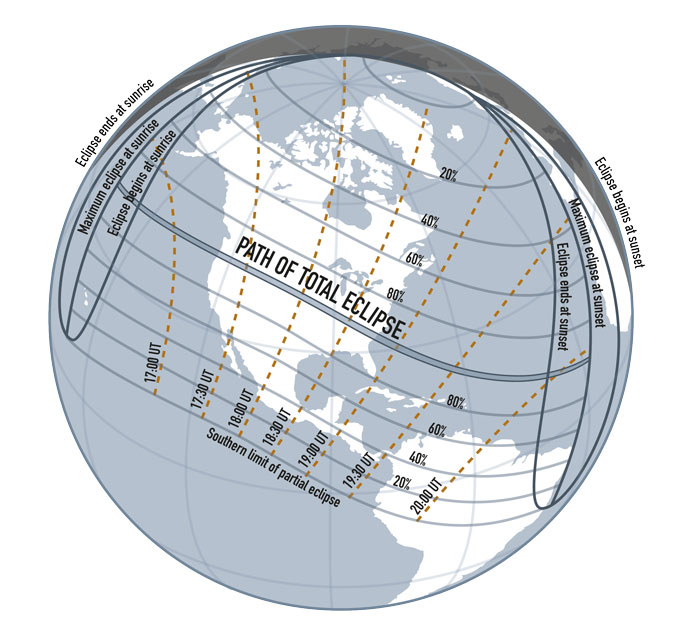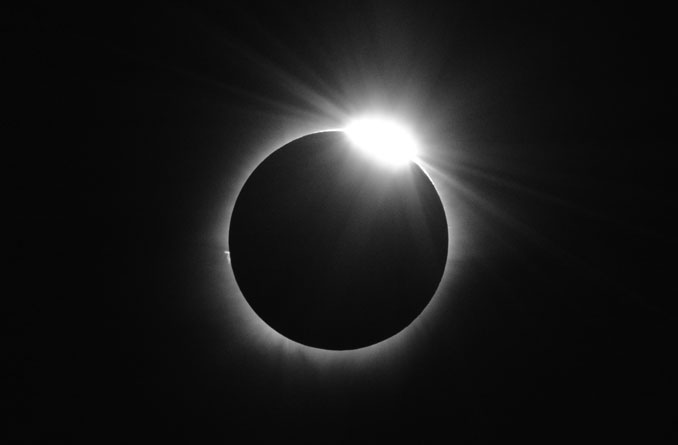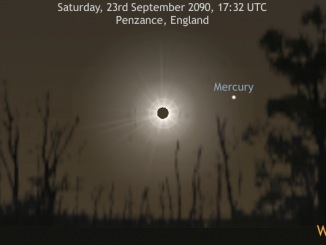It’s been nicknamed the Great American Eclipse as totality returns to the USA for the first time in twenty-six years. On 21 August 2017, the Moon will move in front of the Sun along a strip cutting diagonally across more than a dozen different states, from Oregon on the west coast to South Carolina.

If you can’t get under the path of totality, then you can still observe a partial eclipse, either in the United States or further afield. Indeed, on the evening of 21 August the UK will observe such an event. Plymouth will see 5.3 percent of the Sun obscured beginning and London four percent, both beginning at 7:40pm BST, Leeds 2.9 percent starting at 7:39pm BST and Glasgow 2.3 percent at 7:37pm BST. These are only slight partial eclipses, but they’re better than nothing!
The path of totality
If you can get under the path of totality in the United States, where should you go and what will you see? The Moon’s umbral shadow makes landfall on North America at Yaquina Head Lighthouse, some three miles north-north-west of Newport, on the Oregon coast, at 10:15am local time, bringing an eerie twilight lasting one minute and 50 seconds. The state capital, Salem, is comfortably inside the 62-mile-wide swathe of lunar shadow and experiences one minutes and 54 seconds of totality starting at 10:17am local time. For road travellers who can find a safe place to stop, anywhere along Route 26 east of the Warm Springs Reservation affords a view of totality, or anywhere south of Woodburn on Interstate 5 as far as Brownsville.

Totality then crosses into Idaho, where you should head north on Route 55 anywhere between Horseshoe Bend and Donnelly to experience a fully eclipsed Sun. The Moon’s umbral shadow then clips the state of Montana before continuing onto Idaho Falls at 11:33am local time. Passing into Wyoming, eclipse chasers may be afforded some of the best views when darkness engulfs the 4,200-metre-high Grand Teton mountain in the Teton Range for two minutes and 14 seconds. Drivers should note that the entire length of Route 26 within the state will experience totality, so pull over and enjoy the view! The city of Casper lies just north of the central eclipse line, where totality arrives at 11:42am local time and totality lasts two minutes and 26 seconds, but sadly state capital Cheyenne is too far south.
The 68-mile wide umbral shadow now moves into Nebraska, with the city of Grand Island lying close to the eclipse centre line where totality arrives at 12:58pm local time and lasts for two minutes and 33 seconds. Drivers anywhere on Interstate 80 east of North Platte through to the state capital of Lincoln will be engulfed by the Moon’s umbral shadow. The heart of Lincoln lies just four miles inside the northern limit of the umbral shadow, hence it experiences just one minute and ten seconds of totality starting at 1:02pm local time.
The eclipse path moves into neighbouring Kansas, where it passes over Rosecrans Memorial Airport. In North Kansas City, totality lasting one minutes and nine seconds arrives at 1:08pm local time, before the eclipse path crosses the Missouri River state boundary at 1:06pm. St. Joseph lies very close to the eclipse centre line and experiences two minutes and 38 seconds of totality starting at 1:06pm local time. Anyone travelling south-east on Interstate 29 from Rock Port through St Joseph to Kansas City will experience a total eclipse, so find some place to pull over by 1pm to prepare for the show! Along Interstate 70 east of Kansas City is another good place to experience totality, particularly in Columbia. Here, totality arrives at 1:12pm local time and the Sun is obscured for two minutes and 36 seconds. Meanwhile, state capital Jefferson City experiences two minutes and 30 seconds of darkness at 1:13pm.
Longest and greatest eclipses
The centre line of totality crosses the Mississippi River at 1:18pm local time. This is the state to be in if you wish to experience the greatest duration of eclipse – the instant when the length of totality reaches a maximum along the centre line. Greatest duration occurs at 37° 34’ 04” N, 89° 06’ 10” W, where a total eclipse of two minutes and 41.6 seconds starts at 1:20pm local time. The Blue Sky Vineyard (blueskyvineyard.com) is as close as you can get to greatest duration, where a festival is planned and maybe a special-label wine released! The nearest city is Carbondale in Jackson County, some 12 miles north-west. Drivers on Interstate 57 south of Benton through to Mounds will be in the path of totality.

Alternatively, Kentucky is the place to be if you wish to experience the ‘greatest eclipse’ – the instant when the axis of the Moon’s shadow cone passes closest to the centre of the Earth, occurring at 36° 57’ 59” N, 87° 40’ 14” W. Here, maximum eclipse occurs at 1:25pm local time, the mid-point of totality lasting two minutes and 41.2 seconds. Put simply, greatest eclipse lies 12 miles north-west of Hopkinsville, a city whose northern suburbs lie exactly on the central eclipse line, where two minutes and 41 seconds of totality arrives at 1:24pm local time. Travellers by road anywhere along Interstate 24 east of Paducah through to Nashville, Tennessee, which is engulfed in darkness for a maximum of one minute and 56 seconds starting at 1:27pm local time, will see totality.
The path of totality clips the western edge of North Carolina. The heart of the Moon’s shadow passes over the Nantahala National Forest at 2:36pm local time when the duration of the total eclipse is two minutes and 38 seconds. Locations south-west of Cherokee to the Georgia state border will have the best views of totality. In Georgia, those prepared to visit Pine Mountain in the extreme north-eastern tip of the state and park somewhere alongside Route 28, will see two minutes and 37 seconds of totality.
The band of totality then sweeps into South Carolina, where the city of Greenville is engulfed by the lunar umbral shadow at 2:38pm local time for two minutes and 10 seconds. State capital Columbia lies just ten miles north-east of the eclipse centre line, and experiences two minutes and 30 seconds of darkness starting at 2:41pm local time. Here the eclipsed Sun is 61.9 degrees high in the southwest. The centre of the Moon’s umbral shadow finally eclipses the Sun in Charleston on the North Atlantic coast, where totality arrives at 2:46pm local time and lasts one minutes and 34 seconds. For travellers by road, anywhere along Interstate 26 from ten miles south of Spartanburg, through Columbia, all the way to Charleston will experience a total solar eclipse.
This article was first published in the Astronomy Now 2017 Yearbook. Copies are still available priced just £1.99 and you can pre-order the 2018 Yearbook now.



